
Last week, I posted on the Gurmat Gian Group’s performance of classical keertan. This all Sikh women’s group, expect  for a tabla player, is based in Ludhiana, Punjab. This week, I wanted to share a brief interview with one of its members, Keerat Kaur.
for a tabla player, is based in Ludhiana, Punjab. This week, I wanted to share a brief interview with one of its members, Keerat Kaur.
1. How did you come to join the Gurmat Gian Group? How long have you been with the group? How often does the group meet?
The Gurmat Gian Group was formed by my mother Gurpreet Kaur. My mother Gurpreet Kaur and myself used to do kirtan in the weekend gatherings of Gurmat Gian Missionary Trust. These programmes are held every Saturday and Sunday. Impressed with our singing, we were asked by the organizers and especially by Rana Inderjit Singh to train young boys and girls to do kirtan. Now Gurpreet Kaur takes regular classes at the Gurmat Gian Missionary College where many girls and boys of different age groups are learning kirtan.
Encouraged to go in to recording Gurabni Kirtan lead to the formation of Gurmat Gian Group which now has 5 CDs to its credit.
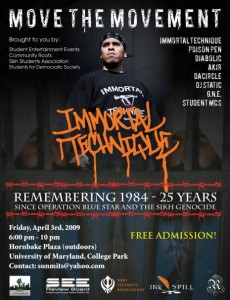 I know this concert has already been discussed, but the event had been postponed to this coming Friday…and with all the local buzz…it got me thinking about how we remember 1984.
I know this concert has already been discussed, but the event had been postponed to this coming Friday…and with all the local buzz…it got me thinking about how we remember 1984.
The Sikh Student Association here at the University of Maryland, in conjunction with other student groups, is sponsoring a free concert on April 3rd, 2009 to mark the 25th anniversary of the 1984 Sikh genocide. In a previous post Truth To Power – in reference to the recent Ensaaf report, I had stated:
We must read such reports and present them … anywhere and everywhere … to anyone who will listen: our gurdwaras, our local Amnesty International chapters, student groups, talk radio, public television, newspaper op-eds, etc. We must also create awareness of these findings in whatever format we can – through music, art, theatre and poetry.
The featured performer for the concert is Immortal Technique, an up-and-coming rapper who attracts a large and diverse audience, especially amongst college students. His intense style, controversial lyrics, and willingness to approach political subjects, such as the mid-east conflict, have made him a fan favorite amongst the politically aware.
It is refreshing to see students think “out-of-the-box” in remembering 1984, by attracting a mainstream artist and joining forces with other student activist groups under the tagline “Move the Movement.” The SSA plans to distribute background material on the 1984 atrocities and subsequent human rights violations, as well as feature short video clips and interviews with victims in between acts.
The G20 summit, which will take place in London on April 2nd, will bring together world leaders representing 85% of the world’s output to discuss issues affecting the international financial system. The goal of this summit is to encourage world leaders to make three committments:
- First, to take whatever action is necessary to stabilize financial markets and enable families and businesses to get through the recession.
- Second, to reform and strengthen the global financial and economic system to restore confidence and trust.
- Third, to put the global economy on track for sustainable growth.
 This week, religious leaders in Britain urged the G20 leaders not to forget their commitments to the world’s poorest people in the current economic crisis. In a joint statement, they quoted World Bank figures suggesting 53 million more people may fall into absolute poverty as a result of the crisis, and said the world’s leaders have a duty to help them.
This week, religious leaders in Britain urged the G20 leaders not to forget their commitments to the world’s poorest people in the current economic crisis. In a joint statement, they quoted World Bank figures suggesting 53 million more people may fall into absolute poverty as a result of the crisis, and said the world’s leaders have a duty to help them.
In a communiqué issued in advance of next week’s G20 meeting in London, they call on political leaders to consider the moral issues at the root of the current financial crisis, and to pay special attention to the needs of poor, marginalised and vulnerable people: “to forget their needs would be to compound regrettable past failures with needless future injustices”. [link]
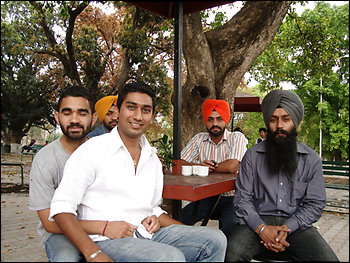 The story is hardly new. Every few weeks, we see reports by journalists that reinforce a well-known reality – many Sikh men in Punjab are cutting their hair and removing their turbans. I am hardly an alarmist. I do believe that despite the overwhelming trend, there are countercurrents as well. In an earlier post, I described what I have termed a ‘Sikh turn’.
The story is hardly new. Every few weeks, we see reports by journalists that reinforce a well-known reality – many Sikh men in Punjab are cutting their hair and removing their turbans. I am hardly an alarmist. I do believe that despite the overwhelming trend, there are countercurrents as well. In an earlier post, I described what I have termed a ‘Sikh turn’.
Although many Sikh youths have for the time being removed their turbans, their sense of a religio-ethnic identity still remains strong. Maybe the temptations of modernity and especially the desires of the opposite sex are strong and many feel that at this point in their life they would rather pursue women and cannot live up to the great ideals of their Gurus. This should not be read as a rejection of those ideals but a realization of where they are and their priorities at this time. (Though this may be the case of those that remove their pagri on their own account and not in those families and children where they never had it as many in the diaspora)
As discussed previously, the ‘Sikh turn’ is occurring. The psychological tragedy of the post-1993 Sikh community is beginning to wane and we may be witnessing the dawn of a new era. It may not be in the Khalsa symbolic form that many hope, but a religio-ethnic movement is occurring. The youth are not disinterested and disconnected; they are engaged and can be mobilized. The pull of the pagri is not dead in Punjab either as we see many Bihari migrants joining the Qaum’s ranks. This is a good sign. A new generation will soon have its own version of ‘pagri sambhal jatta.’[link]
A recent article in the Washington Post revisits the issue, highlighting a looming impending court case.
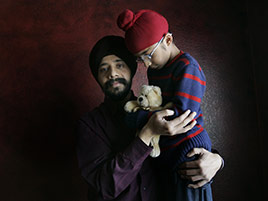 A couple of days ago Darshan Singh took his six-year-old son, Gurjot, to the post office to get a U.S. passport. Unfortunately, his experience is all too familiar: postal workers refused to take Gurjot’s photo, insisting he remove his “hat”:
A couple of days ago Darshan Singh took his six-year-old son, Gurjot, to the post office to get a U.S. passport. Unfortunately, his experience is all too familiar: postal workers refused to take Gurjot’s photo, insisting he remove his “hat”:
A Frisco father says his family’s trip to the post office turned into an emotional experience after a postal worker refused to take his son’s passport picture while the boy was wearing a turban…
“We kept telling them, ‘it’s not a hat,’” Singh said. “I want to make sure that doesn’t happen to any other kid of my religion.”
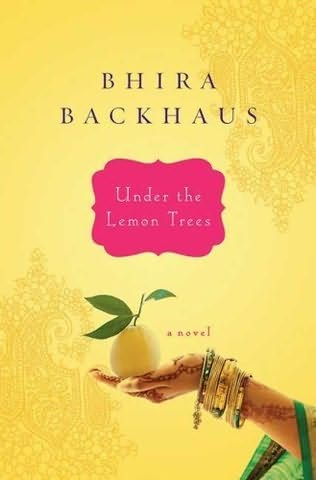
“A young woman scarcely had time to weave the fragile fabric of her dreams in our town.”
This is one of the opening lines of Bhira Backhaus’ debut novel, Under the Lemon Trees. The novel – published this month – is set in a small town in Northern California, and tells the story of two generations of a Sikh family facing difficult decisions about love, cultural traditions, and familial ties. The story focuses upon the life of 15-year-old Jeeto who stuggles between embracing her heritage and fitting in as an American and journeys through her reconciliation of the possibilities of freedom and love (I’m sure many of us can relate to one or all of these!). The publisher describes the novel as part Bend it Like Beckham, part Monsoon Wedding.
The book is based on the author’s own experiences growing up in a small-town Sikh community in California’s Sacramento Valley.
“It’s a story that I’ve [always] known I wanted to tell,” she said.
Dealing with cultural disconnect is one of the story’s driving forces, Backhaus said, but many of the novel’s themes, such as the search for love, identity and dignity, are cultural universals she hopes appeal to people of all backgrounds. Although she said she hopes “Under the Lemon Trees” will have similar success to the string of popular tales of the Indian experience, such as “Slumdog Millionaire” and the novels of Jhumpa Lahiri, Backhaus said her work is different. “Under the Lemon Trees” tells the story of Sikh Indians immigrating to California from lower-class villages in India, she said – a story that has not been told by other successful media depictions of Indian life. [link]
I’d be interested in doing a full review of this novel once I’ve finished reading it. In the meantime, here’s an excerpt from the first chapter.
There was an interesting story recently on Cultural Diversity Day at a local middle school. In addition to featuring dancing, self-defense, and dialogues, a few speakers lectured on their experiences or cultures, including a Sikh speaker:
Wearing a bright blue turban that matched his outfit, Gurparkash Singh, a scientific writer for Bristol-Myers Squibb, told about the Sikh faith. He said it’s easy to identify a Sikh person by looking at the shape of his or her turban. Sikh turbans are triangular and stop at the nape of the neck.
The writers covering the story spoke of the event as going “beyond diversity” and pushing forward what cultural diversity days are all about. It sounds like the event was really well-rounded and incorporated a lot of communities and backgrounds (and probably went far beyond “cultural” diversity to many different concepts of community diversity). I find myself uncomfortable, however, with classifying a religious community as “cultural,” and further, with tokenizing different communities on a single day of diversity awareness instead of incorporating a diversity-framework or lens into an educational or pedagogical model.
I recently came across this CNN report of four individuals who discuss their experiences of wearing religious garments in the US. Two of the individuals are Sikh men (where are the Sikh women at) along with a Muslim woman and a Jewish man.
Ajitpal Singh Rania: Ajitpal lives in the Washington area and immigrated to the United States pre-9/11 into a college town. Aside from curious looks, he feels that he has not really been discriminated against as a Sikh wearing a turban because he arrived in a college town that was more open to diversity. Ajitpal also believes that educational workshops have helped many American learn more about Sikhs. Watch his video report here.
Syeda Martha Graham: Syeda of Kansas City, Missouri, converted to Islam and made a personal decision to not only wear a head scarf but also a face cover. Not wearing her head scarf makes her feel vulnerable, similar to how others feel about not wearing a top. She remembers an incident where a bank employee asked her to take her “mask” off; but another employee came to her defense. Syeda feels more people are nice than offensive. She also wishes people would assume less and ask more questions. Watch her video clip here.
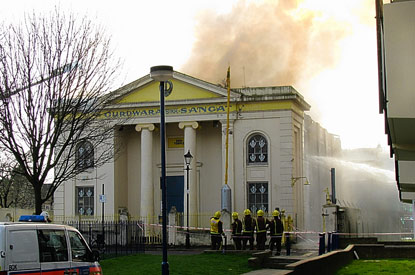 Recent news from East London is that Gurdwara Sikh Sangat has been substantially destroyed in an attempted arson attack. An official statement of the Executive Committee of the Gurdwara Sikh Sangat states that,
Recent news from East London is that Gurdwara Sikh Sangat has been substantially destroyed in an attempted arson attack. An official statement of the Executive Committee of the Gurdwara Sikh Sangat states that,
On Monday the 16th March 2009 at approximately 1.30pm, whilst some women were attending a Satsang a male person unknown to the worshipers entered the Temple through a side entrance. One of the worshipers came from the main hall and confronted the intruder coming down from the top floor and inquired why he was in the building. He replied that he had come to meet someone and then ran out.
Shortly after a fire was discovered coming from the top floor Sachkhand room (this room is where the Guru Grant Shaibs/holy books are kept) within the Temple complex. [link]
Most of the gurdwara’s roof has collapsed and the community fears that all but one of the Granth’s kept inside the gurdwara have been destroyed. The women who were in the gurdwara at the time were able to rescue one Granth from the flames, but unfortunately not the others.
“I can’t describe how important those holy books were to the Sikh community,” he added. Kulvinder Singh Virk, 26, who runs a local off-licence and is also a member of the temple, said: “This is very personal for us. It’s as if a member of our family has been burnt to death.” [link]
One worshipper said that in the past few weeks he had noticed racist graffiti on one of the gurdwara’s outer walls.
No longer are Punjabi “staarz” (i.e. Gurdas Maan, Arminder Gill, etc.) or Sukhbir Singh Badal’s Mrs., Harsimrat Kaur Badal (i.e. Nanhi Chhaan project), the only ones focusing on the “girl child”, but also a granthi at a California Gurdwara. I was recently surprised to hear a granthi support the idea of gender equity as part during his Punjabi kathaa of a shabad he was singing. No he wasn’t a renaissance granthi, but a common one you would encounter in your general Gurdwara. The sangat wasn’t full of progressive youth/parents, but consisted of lay-persons. AND the focus of his kathaa wasn’t gender equity, but our needs/yearnings. So you may ask how was he promoting gender equity? Well, he used the yearning for a thee (daughter) or puthar (son) in the SAME example to help the sangat understand the shabad’s message. In my experience, the yearning for a daughter and son are never used together to help the sangat think beyond their wants and just accepting Waheguru’s will. Common examples are a yearning for a betaa or a mother caring for a betaa (we could also add a big house and nice car to the list). I have never heard of a yearning for a betee or caring for a betee. It has been during these kathas that the contradiction between theology and contemporary practice of Sikhi have been poignantly highlighted for me. Yes, theologically we believe in gender equity (it’s in Gurbani with examples in Sikh history). However, the common examples used to intimately relate and rely the Guru’s message to an every-day (opppss … maybe I should say Wednesday and Sunday) sangat reify gender inequity. From my perspective, I was finally hearing a common granthi make an attempt to break away from mold.
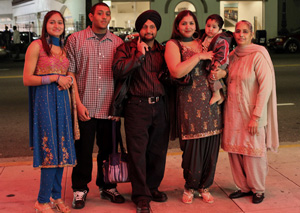 Although I am long since removed from the “bhangra scene”, still I thought this was interesting montage compiled by the Los Angeles Times in their “street culture” section, highlighting 11 great pictures on the Sights of Socal Bhangra.
Although I am long since removed from the “bhangra scene”, still I thought this was interesting montage compiled by the Los Angeles Times in their “street culture” section, highlighting 11 great pictures on the Sights of Socal Bhangra.
The thumping, driving beat of bhangra –a style of folk music from the Indian state of Punjab, the Sikh homeland — reverberated through the walls of the Wilshire Theatre in Beverly Hills Saturday as young people from around the continent converged for the SoCal Bhangra Competition (socalbhangra.com).
Check out the montage.
 Last week, the International Criminal Court (ICC), issued an arrest warrant for current President of Sudan, Omer Hassan Al-Bashir. Al-Bashir has been charged with five counts of crimes against humanity: murder, extermination, forcible transfer, torture and rape. He also faces two counts of war crimes. The ICC may be growing its first tooth.
Last week, the International Criminal Court (ICC), issued an arrest warrant for current President of Sudan, Omer Hassan Al-Bashir. Al-Bashir has been charged with five counts of crimes against humanity: murder, extermination, forcible transfer, torture and rape. He also faces two counts of war crimes. The ICC may be growing its first tooth.
Behind the warrant were the many groups that have tirelessly worked to bring global attention to the matter. The ‘Save Darfur’ campaign has been extremely successful example in rallying public support, beginning in churches and university campuses, to influence the public dialogue and bring pressure upon public officials. Through organizing local events, but aiming to influence public opinion on a global level, the campaign is a model in their use of new media, internet, and public rallies and theatre to bring attention to the genocide and plight of a people. While I am in admiration of the campaigns strategies and efforts, it is still worthwhile to ponder on global culpability in allowing such genocides to continue to occur.
As part of these efforts, the campaign has been successful in bringing pressure upon China for its continued support of the genocidal regime and its willingness to condone the Sudanese government’s behavior in its bid to keep receiving returns on its billions of dollars investment into the country’s oil industry. Although on some level I understand realpolitik and China’s strategy of attempting to find oil supplies in those states that are considered pariahs by the US in order for China to satiate its growing oil needs. Still I cannot condone such actions and cannot trade human life for oil.
Grassroots efforts and political efforts are starting to show that the pressure upon China for its support of Sudan is beginning to have effect. Steven Spielberg’s boycott of the Beijing Olympics was one example. Protecting Sudan through its veto ability in the Security Council of the United Nations (UN), it is understandable why world pressure focuses on China. It is heartening that the pressure may even be beginning to have some effect.
However, left out of the equation is India.
We’ve talked a little bit about the Sikh Youth Slate that ran for gurdwara elections — and won — in Surrey, as well as how mainstream Canadian media was framing the event. In that election, youth won the vote with a platform promising a focus on Sikhi, community-based service, and support for youth diversion activities (ie., building community space at the gurdwara so that adolescents didn’t get sucked into another world of criminal complexity).
What I didn’t know, at the time, was that shortly after the election, the outgoing gurdwara president filed a lawsuit challenging the process/legitimacy of the nominations for election (but not the election itself). A press release circulated today regarding the legal developments in the case, and as a non-Canadian, it is more than a little disorienting.
As I was randomly going through youtube clips a few days ago, I came across the above video of a group of Sikh children in Fremont, who learn kirtan in classical raags. Despite the poor audio, its obvious that they are good and I know this also from having heard them (and some of their contemporaries) in person – they are GOOD.
A couple of weeks ago Jodha reported on an article that brought to light the fact that Sikh children are practicing the tradition of kirtan, but what I think we didn’t discuss there is how this generation of Sikh musicians has really become one of classical musicians, learning stringed instruments of old and performing keertan in the Classical or raag framework. The growth has been obvious, especially in recent years – with the rise of institutions such as the The Raj Academy in Great Britain and the Gurmat Sangeet Department at Punjabi University Patiala, which specialize in providing instruction in traditional (classical) kirtan, and even the Miri Piri Academy in Amritsar of which the Chardi Kala Jatha (classically trained professional Sikh musicians who happen to be American in nationality) is a product.
 Not in India! In India, the state only engages in what is euphemistically called “fake encounters.” While many in the Sikh community remember the tragic events of 1984, in many ways the events did not just transform the Sikh nation, but has had a lasting effect on the Indian state.
Not in India! In India, the state only engages in what is euphemistically called “fake encounters.” While many in the Sikh community remember the tragic events of 1984, in many ways the events did not just transform the Sikh nation, but has had a lasting effect on the Indian state.
Rarely do I see this line of questioning amongst Indian academics, elite, or the media. Violence does not only affect the victim, but the perpetrator is also transformed. Last week, I commented on one such transformation in the Indian State – when a mainstream journalist can openly call for “state terror(ism)” as a tactic to perpetrate against its own citizenry.
This week, in a related story, but still somewhat different, I highlight the euphemism “fake encounter”. Although this term had traction before 1984 and was one of the spearheads against which Baba Jarnail Singh Bhindranwale fought against, it was in the post-1984 Punjab that supposed “encounter deaths” became so widespread and with a complacent Indian press parroting the State’s reports soon found them relegated to back pages. If there truly is a “Punjab lesson”, it was that other Indian State agencies could engage in these “fake encounters” with complete impunity. The latest case comes from the state of Chhatisgarh and the rural areas near Singaram.
 Assemblyman Warren Furutani (D-Long Beach) has introduced a new bill requiring awareness trainings and instruction on how to approach Sikhs for California’s law enforcement agencies and officers. If passed, California, which is home to the oldest Sikh gurdwara in the U.S. (Stockton) and one of the largest Sikh populations in the country, would take affirmative steps to ensure that the rhetoric around national security is not inappropriately utilized to prevent Sikhs from the free and fully practice of our faith.
Assemblyman Warren Furutani (D-Long Beach) has introduced a new bill requiring awareness trainings and instruction on how to approach Sikhs for California’s law enforcement agencies and officers. If passed, California, which is home to the oldest Sikh gurdwara in the U.S. (Stockton) and one of the largest Sikh populations in the country, would take affirmative steps to ensure that the rhetoric around national security is not inappropriately utilized to prevent Sikhs from the free and fully practice of our faith.
Assemblyman Furutani explained the need for this protection specifically in the context of the kirpan:
Since the Sept. 11 terrorist attacks, Sikhs carrying the blade, which they consider sacred, have experienced a sharp increase in prosecutions, according to the legislation, AB 504, that Furutani has introduced.
“The Sikh community should not live in fear of arrest by law enforcement for carrying the kirpan, which is an integral part of their religious faith.” [link]
In light of the horrific experience of the Tagore family in Texas, it sounds like this kind of forward-looking legislation could prevent instances of ignorance-based harassment, or at the very least provide a legal basis for holding police officers accountable to culturally appropriate standards of enforcement for the diverse communities in which they work. The bill will be reviewed in March, and it will be interesting to see if it’s able to gain political traction in the upcoming legislative session.
The Center for Asian American Media (CAAM) is a group working to present stories that convey the “richness and diversity of Asian American experiences” to the broadcast audience. They do this by funding, producing, distributing and exhibiting works in film, television and digital media. One example is this video directed for Mandeep Sethi, a bay area MC. As he says, Where do we go from here, I thought my people would be proud of their heritage and instead they want to bury it.
Also presented by the Center, is the upcoming 27th Asian American Film Festival in San Francisco. For those of you in the area, here are some of the films you might want to catch.
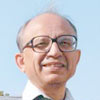 I have blogged about this issue before and since I find it so irritating, expect me to highlight them over and over. The most recent re-incarnation of the ‘abuse’ of the ‘Punjab Lesson’ comes from the always problematic Times of India. Swaminathan Aiyar, a libertarian columnist, in his “Swaminomics” has just written “Pakistan needs a Beant Singh”.
I have blogged about this issue before and since I find it so irritating, expect me to highlight them over and over. The most recent re-incarnation of the ‘abuse’ of the ‘Punjab Lesson’ comes from the always problematic Times of India. Swaminathan Aiyar, a libertarian columnist, in his “Swaminomics” has just written “Pakistan needs a Beant Singh”.
Decrying the truce reached by the Pakistani government and tribal forces in the Swat Valley, Aiyar sees parallels with India in the 1980s and specifically Punjab:
The Taliban’s rise in Pakistan has something in common with Bhindranwale’s rise in Punjab. A religious preacher, he sought to purge Sikhism of modern evils and return to pristine Sikhism. He was outraged by reformist Sikhs like the Nirankaris, and his followers killed many Nirankaris including the Nirankari Baba. [Emphasis added][link]
Nirkankaris were reformists? Claiming a living Guru that was greater than the Guru Granth Sahib and opening fire on protesting Sikhs in 1978 is reform? But I digress….
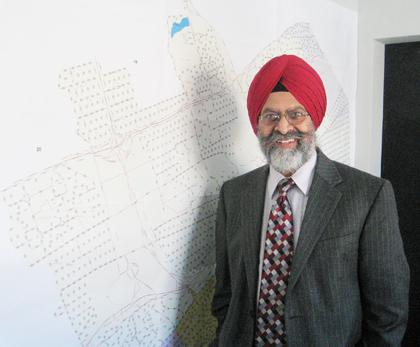
Photo by Howard Koplowitz.
Swaranjit Singh is running for New York City Council, representing Queens. An underdog in a new campaign for a new voting enclave, he’s running, in part, to ensure that “roti-eating people” have a voice, and a say, in New York’s politics:
“My biggest goal is to unite the roti-eating people. Only when we are united, that’s the way we can get any [political] positions,” Singh said… “We can make a difference…” [link]
He emphasized that he’s running to represent all people in the district, but that the desi population in the region is rapidly growing and that there’s a need for community participation and cultural understanding throughout government. At present, desis (mostly Sikh) represent roughly 34% of his district’s population.
 Growing up where I did, singing hymns and listening to the Our Father, Who Art in Heaven prayer were a daily occurrence. There was only one religion taught in my school. It was a point of discontent for those of us who followed other faiths and after years of students petitioning to be exempted from such morning meetings, my school reluctantly made exceptions for us. My school was a public school but it was also in England where separation of church and state did not exist.
Growing up where I did, singing hymns and listening to the Our Father, Who Art in Heaven prayer were a daily occurrence. There was only one religion taught in my school. It was a point of discontent for those of us who followed other faiths and after years of students petitioning to be exempted from such morning meetings, my school reluctantly made exceptions for us. My school was a public school but it was also in England where separation of church and state did not exist.
I don’t have a problem with teaching religion in schools, actually I think religion should be discussed at school but practice should not enforced. I do recognize that this raises the question of Sikh-based schools where religious education is provided in accordance with the Sikh faith. However, I will emphasize that these faith-schools are private schools and children often have a choice to attend those institutions.
It seems that the concept of separation of state and church has in effect reduced the amount of time/effort which is spent on teaching religion in schools. A recent article discusses a school in Modesto, California which has decided that learning about world religions is an important subject and in fact, have even made it a graduation requirement.
Johansen High School in Modesto, California, sounds like any other, until the sacred Hindu sound – “ommmmmm” – vibrates from history teacher Yvonne Taylor’s classroom. Today, she’s talking about Hindu ideas of the cycle of death and rebirth. This nine-week course for ninth graders teaches the fundamental beliefs of Christians, Muslims and Confucianists, as well as Hindus, Buddhists, Sikhs and Jews – all tied in with the history of religious liberty in the United States. [link]

